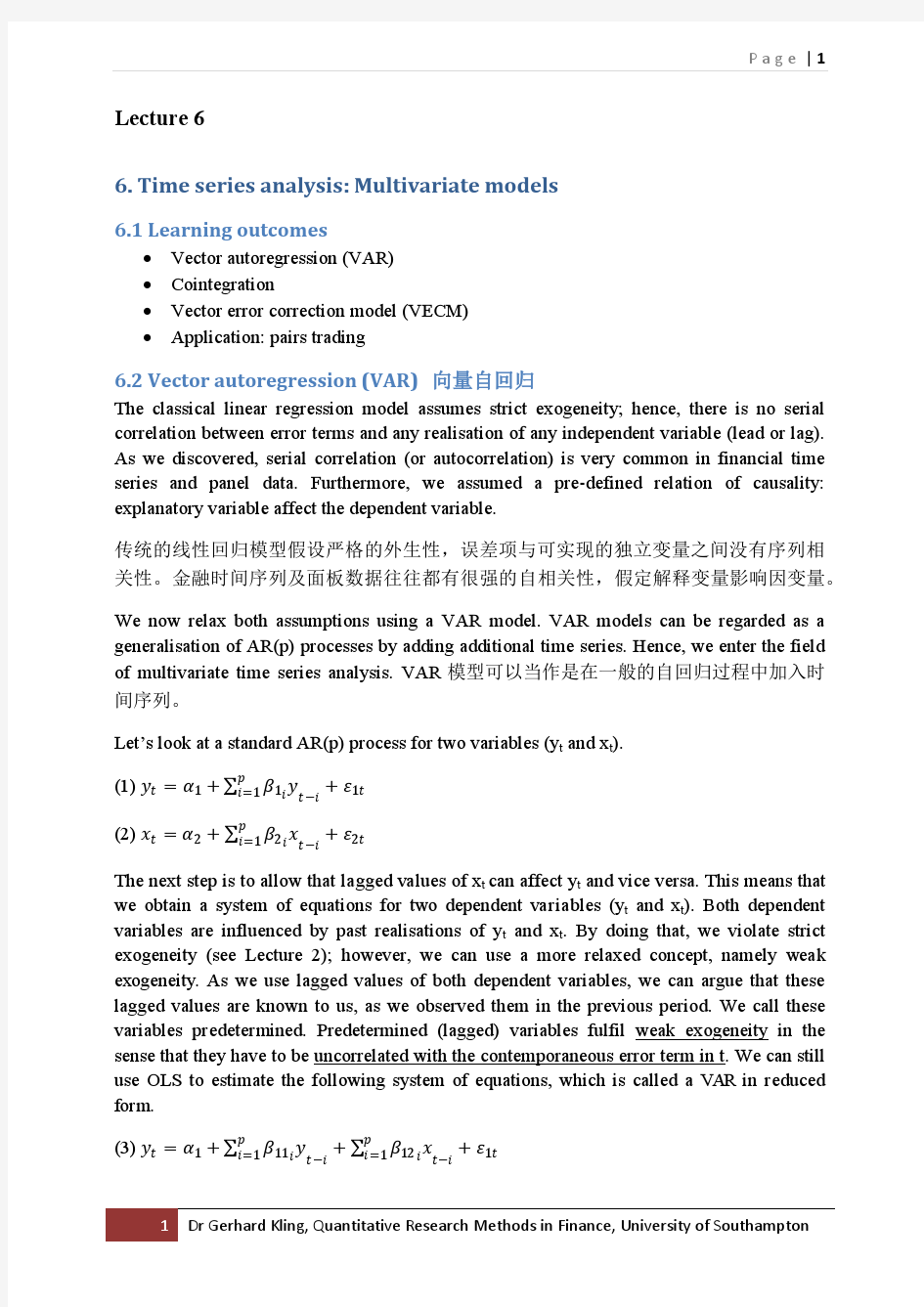时间序列分析及VAR模型

相关主题
- 1、下载文档前请自行甄别文档内容的完整性,平台不提供额外的编辑、内容补充、找答案等附加服务。
- 2、"仅部分预览"的文档,不可在线预览部分如存在完整性等问题,可反馈申请退款(可完整预览的文档不适用该条件!)。
- 3、如文档侵犯您的权益,请联系客服反馈,我们会尽快为您处理(人工客服工作时间:9:00-18:30)。
Page |2
(4) ������������ = ������2 +
源自文库
������ ������ =1 ������21 ������ ������������−������
+
������ ������ =1 ������22 ������ ������������−������
+ ������2������
The beauty of this model is that we don’t need to predefine whether x or y are endogenous (the dependent variable). In fact, we can test whether x (y) is endogenous or exogenous using Granger causality tests. The idea of Granger causality is that past observations (lagged dependent variables) can influence current observations – but not vice versa. So the idea is rather simple: the past affects the present, and the present does not affect the past. STATA provides Granger causality tests after conducting a VAR analysis, which is based on testing the joint hypothesis that past realisations do not Granger cause the present realisation of the dependent variable. In many applications, VAR models make a lot of sense, as a clear direction of causality cannot be predefined. For instance, there is a substantial literature on the benefits of internationalisation (e.g. entering foreign market through cross-border M&A). There is evidence that multinationals outperform local peers due to the benefits of operating in many countries. At the same time, we know that high-performing companies are more likely to enter foreign markets due to their ownership specific advantages. This argument is based on the Resource-based View and the OLS framework developed by Dunning and Rugman (Reading School of International Business). The VAR model allows you to incorporate both effects: in fact you can test whether performance drives internationalisation or internationalisation drives performance. Before you start using a VAR model, you have to make sure that the time series are stationary. So the first step is to check whether the time series is stationary using Dickey-Fuller tests and KPSS tests. The second step is to specify the optimal lag length (p) of the model. This is done by comparing different model specifications using information criteria. Apart from using Akaike (AIC) and Bayesian Schwarz (BIC), the Hannan-Quinn (HQIC) is commonly used. Most applied econometricians favour the Hannan-Quinn (HQIC) criterion. STATA will help you to make a good choice. After specifying your model, you need to check stability conditions. The coefficient matrix of the reduced form VAR has to ensure that the iteration sequence converges to a long-term value. STATA will help you in checking stability. To be precise, you need to show that the eigenvalues of the coefficient matrix lie within the unit circle. The reason behind it can be only understood when you understand the method of diagonalizing a matrix. VAR models offer another nice feature: impulse response functions. VAR models capture the dynamics of two (or more) stationary time series; hence, we can assess the dynamic impact of a marginal change of one variable on another. The standard OLS regression provides coefficients, and coefficients refer to the partial impact of an explanatory variable on the dependent variable. In the case of VAR models, the relationship becomes dynamic, as a change of one variable (say x) in t can affect x and y in t+1. The impact on x and y in t+1 in turn affects x and y in t+2 and so on until the impact dies out. Impulse response functions are very useful in illustrating the short-term dynamics in a model.
Page |1
Lecture 6 6. Time series analysis: Multivariate models
6.1 Learning outcomes
Vector autoregression (VAR) Cointegration Vector error correction model (VECM) Application: pairs trading
6.2 Vector autoregression (VAR) 向量自回归
The classical linear regression model assumes strict exogeneity; hence, there is no serial correlation between error terms and any realisation of any independent variable (lead or lag). As we discovered, serial correlation (or autocorrelation) is very common in financial time series and panel data. Furthermore, we assumed a pre-defined relation of causality: explanatory variable affect the dependent variable. 传统的线性回归模型假设严格的外生性,误差项与可实现的独立变量之间没有序列相 关性。金融时间序列及面板数据往往都有很强的自相关性,假定解释变量影响因变量。 We now relax both assumptions using a VAR model. VAR models can be regarded as a generalisation of AR(p) processes by adding additional time series. Hence, we enter the field of multivariate time series analysis. VAR 模型可以当作是在一般的自回归过程中加入时 间序列。 Let’s look at a standard AR(p) process for two variables (yt and xt). (1) ������������ = ������1 + (2) ������������ = ������2 +
������ ������ =1 ������11 ������ ������������−������
+
������ ������ =1 ������12 ������ ������������−������
+ ������1������
1
Dr Gerhard Kling, Quantitative Research Methods in Finance, University of Southampton
������ ������ =1 ������1 ������ ������������−������ ������ ������ =1 ������2 ������ ������������−������
+ ������1������ + ������2������
The next step is to allow that lagged values of xt can affect yt and vice versa. This means that we obtain a system of equations for two dependent variables (yt and xt). Both dependent variables are influenced by past realisations of yt and xt. By doing that, we violate strict exogeneity (see Lecture 2); however, we can use a more relaxed concept, namely weak exogeneity. As we use lagged values of both dependent variables, we can argue that these lagged values are known to us, as we observed them in the previous period. We call these variables predetermined. Predetermined (lagged) variables fulfil weak exogeneity in the sense that they have to be uncorrelated with the contemporaneous error term in t. We can still use OLS to estimate the following system of equations, which is called a VAR in reduced form. (3) ������������ = ������1 +
